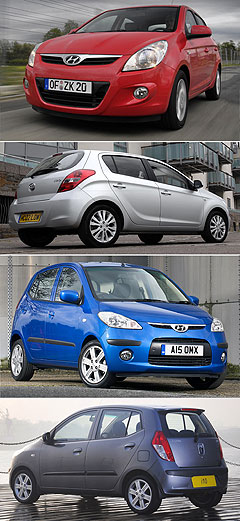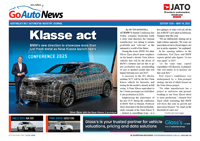Future models - Hyundai - i20New Hyundai i20 here in monthsLight fighter: Hyundai's Indian-built i20 hatch rides on an all-new platform. Hyundai confirms i20 light-car for Oz in early 2010 but not sub-light i10 – yet3 Nov 2009 HYUNDAI has formally announced that its pint-sized i20 hatchback will go on sale in Australia early next year – and it should be joined in about a year by the even smaller i10 hatch. The first Indian-built model to be sold in Australia by Hyundai will be positioned above its own top-selling Getz in the light-car segment, priced higher than the South Korean brand’s $13,990 volume-seller at between $15,000 and $20,000. The all-new i20, which is almost identical in size to the eight-year-old Getz and had been expected on sale here as early as mid-2009, will be available with new petrol engines in both three and five-door body styles. “The i20 built in India has now got a green light and we’ll be bringing that in the early part of the first half of next year,” said Hyundai Motor Company Australia (HMCA) sales and marketing director Kevin McCann at last week’s 2010 Santa Fe launch. “The car has performed spectacularly well within the European market - especially in Britain, where it’s positioned close to the Japanese competitors - and we’re planning the same kind of positioning in Australia.” The sub-light i10 is not officially confirmed for Australia, but Mr McCann said that local availability of the facelifted i10, which is likely to emerge by the end of 2010, represented the most logical opportunity for Hyundai to introduce its second Indian-built model in Australia. “Our research tells us there is an emerging sub-light segment and it’s not there yet but it will come. “The i10 has proven itself to be a great car. (But) we think if we got it now the i10 wouldn’t be that viable, so we’re waiting until we get the next generation or the facelift. “I think that comes some time late next year. How long after that we get it is not confirmed but it won’t be long,” he said. HMCA chief executive Edward Lee confirmed the Getz would eventually be replaced by the i10. “That’s what we are considering but we will see the market situation first,” he said. “The A-segment market is just starting now and we will take a look at what happens with it. Then if it is necessary we will bring that one in. “The light segment is growing and growing. The Getz is relatively old and we have to replace that but it is still is very popular – number one in the segment. “So along with Getz we will bring another one and maybe we could compete with Toyota Yaris and Mazda2. We will position it a little bit higher than Getz so we don’t have to lose any of our market. “It (the i20) is a very, very competitive product. Getz is relatively low-level product, so we could protect a segment with Getz but in this segment we can play with our new i20 and i10,” said Mr Lee. Australia is the only market in the world in which the i20 does not directly replace the Getz, which continues to be built primarily for Australian consumption. Asked when Getz production will cease, Mr McCann said: “I think it’s going to be up to ourselves. The Australian sales rate drives Getz production now, so if it continues it will be up to us when they decide to turn it off. “We’ll make that call, but production will cease at some point next year.  Hyundai i20 front and rear (top) Hyundai i10 front and rear (bottom). Hyundai i20 front and rear (top) Hyundai i10 front and rear (bottom).“In a monetary sense if the entry-level light segment (starts at) about $13,000 and the exit level is $20,000 and we have a Getz at $13,000 to $18,000, the i20 will be something like $15,000 to $20,000 and the i10 could fit in at $12,000 to $16,000. “So you’ve got a series of logical steps from $13,000 to $20,000 and that point Getz would be out.” If sold here, the i10 would follow Suzuki’s Indian-built Alto, which is officially Australia’s most affordable new car with a $12,490 starting price (plus dealer delivery and statutory charges), as the nation’s second sub-light model. HMCA’s sales chief said he was not encouraged by sales of the Alto, which was the first Indian-built model to be released in Australia, since it was launched here in July. “We follow it reasonably closely but we expected it to do better,” he said. “We’re a little bit disappointed it hasn’t, honestly.” HMCA product and public relations manager Ben Hershman said his company was close to resolving shipping logistics for the i10, but suggested that the availability of stability control may not be compatible with HMCA’s preferred pricing structure. “We’ve had cars here for some time evaluating them, so we understand the product and we’ve done some initial research into it here,” he said. “We know that if we need to introduce it here we can. We know we can ship from India. We’ve been looking at what would the breakpoint need to be to ship directly. “We’ve looked at the situation closely with India and we’re very confident we’re very close to concluding what the best option might be, but there are still issues like volumes and currency. “We’re very focussed on safety so we need to make sure that the business case stacks up in terms of ESP, for example. “The i20 is assured but we need to be sure the i10 fits into that puzzle. There are still things that we’re working through right now. Hyundai’s light-sized Accent hatch and sedan is unlikely to be replaced by the facelifted model already on sale in Korea and Mr Hershman said that although minimal sales substitution was expected between the i20 and Getz, the latter’s model range could be trimmed if required. “We believe that the two cars will have different positions in the segment,” he said. “Getz is doing extremely well for us, so we will leave Getz to do what it needs to do. “There will be crossover for a period of time and if we need to adjust the Getz line-up we will be able to, because we have a very strong relationship with the factory. We can be flexible.” As we revealed exclusively in June, HMCA received Australian Design Rule approval for six versions of the i20 in May – including a 66kW U-Series 1.4-litre turbo-diesel hatch and wagon. But Mr McCann said the diesel i20s would not be made available here, despite Hyundai’s success with 1.6-litre CRDi versions of its i30, Australia's third-best selling small car. Almost a quarter of all i30s sold this year were diesel, including 22 per cent of hatches and 38 per cent of wagons, totalling nearly 5000 vehicles. Correspondingly, fleet sales accounted for 25 per cent of i30 hatch sales and 48 per cent of i30cw wagon sales. The i30, which was launched here in 2007 and proved more popular than even the Getz in the past two months, now comes with a five-star ANCAP safety rating across the range following the standard fitment of side and curtain airbags on entry-level SX versions of the hatch and wagon from October. “Although we could put a diesel engine in the i20 if we wanted to we probably won’t,” said Mr McCann. “We had a really close look at that and the experience with i30, Sonata and Grandeur has given us a deeper understanding of diesel engines in the Australian market. “Before we launched i30 in Australia we did some historical research to track the diesel versus petrol price per litre and although it fluctuated on average the gap was quite consistent. “The i30 launch coincided with booming all world oil prices so the gap widened and it hasn’t really come back, therefore that rolling average no longer applies and diesel to a certain extent has to be thought about differently. “Diesel still has a role to play in the SUV segment ... but lower down the four-cylinder petrol engine is already very economical and people are happy with the economy of petrol engines. Small cars are also quite price sensitive so to expect them to pay $2500 more for a diesel is much more difficult. “We just don’t think it would sell unless it was a special ‘green’ model like those sold by some of our competitors, which are more marketing models anyway.” Mr McCann said the i30 diesels would continue on sale. “Diesel for i30 is not under review. Its share fluctuates over a considerable proportion on a monthly basis and in a laggy kind of way almost reflects the (diesel) pump price – by between 20 and 40 per cent. Twenty per cent is enough,” he said. While the lack of an automatic transmission and cruise control has also worked against the local business case for the i20 diesel, the petrol version will be powered by Hyundai’s new 74kW 1.4-litre and 91kW 1.6-litre ‘Gamma’ four-cylinder engines, mated to both five-speed manual and four-speed automatic transmissions. Like the i30 and facelifted Santa Fe, the chassis of the PB-series i20, which HMCA unveiled at this year's Melbourne motor show and has already received a five-star Euro NCAP rating, will be modified for Australian conditions following local testing.  Read more |
Click to shareHyundai modelsResearch Hyundai Motor industry news |
















Facebook Twitter Instagram